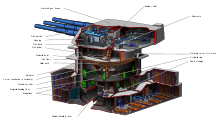Barbette
This article needs additional citations for verification. (October 2008) |


A barbette is a protective circular armour feature around a cannon or heavy artillery gun. The name comes from the French phrase en barbette referring to the practice of firing a field gun over a parapet (defensive wall) rather than through an opening (embrasure). The former gives better angles of fire but less protection. For example, the Confederate defenders at the Second Battle of Fort McAllister were unable to operate their cannons because the en barbette gun emplacements provided poor protection from Union riflemen outside the fort.[1]
Before the complete introduction of the fully enclosed armoured gun turrets, a barbette was a fixed armoured enclosure protecting the gun. The barbette could take the form of a ring of armour around the gun mount over which the guns (possibly fitted with a gun shield) fired.
In warships from the age of the dreadnought forward, the barbette is the non-rotating drum beneath the rotating gun turret (the latter is properly known as the "gunhouse") and above the armoured deck on a warship. It forms the protection for the upper ends of the hoists that lift shells and their propelling charges (e.g. cordite) from the magazines below.
When applied to military aircraft, largely in aviation history books written in British English, a barbette is a position on an aircraft where a gun, or guns, are in a mounting which has a restricted arc of fire when compared to a turret, or which is remotely mounted[2] away from the gunner. As such it is frequently used to describe the tail gunner position on bombers such as the Boeing B-17 Flying Fortress, with American English aviation books usually describing this position as a "flexible" gun mount, when the term "turret" itself is not used.
The term "barbette" is also used by some, again primarily in British English, to describe a remotely aimed and operated gun turret emplacement[3] on almost any non-American military aircraft of World War II, but not usable in a direct translation for the German language term used on Luftwaffe aircraft of that same era. As an example, the German Heinkel He 177A heavy bomber had such a remotely-operated twin-gun Fernbedienbare Drehlafette FDL 131A powered forward dorsal gun turret, with the full translation of the German term comprising the prefix as "Remotely-controlled rotating gun mount".[4] The Germans of the World War II era themselves always used the generic term lafette, translating as "gun mount" of any generally mobile type as an integral part of the nomenclature for describing these remotely controlled weapon mounts on their military aircraft, and indeed for almost any movable defensive gun mount in German World War II-era aircraft.
See also
select an article title from: Wikisource:1911 Encyclopædia Britannica
- Disappearing gun, an intermediate step between barbettes and gun turrets
Notes and references
- ^ Trudeau, Noah Andre. Southern Storm: Sherman's March to the Sea. New York: Harper Collins, 2008
- ^ Flight 19 June 1947 p573
- ^ Flight 16 February 1950 p232
- ^ Griehl, Manfred; Dressel, Joachim (1998). Heinkel He 177 - 277 - 274. Shrewsbury, UK: Airlife Publishing. pp. 243–245. ISBN 1-85310-364-0.
